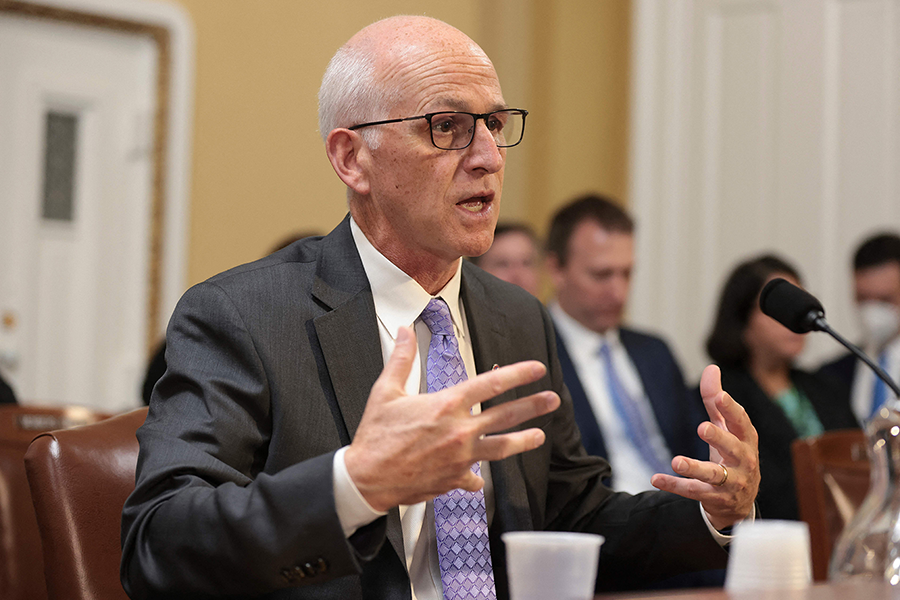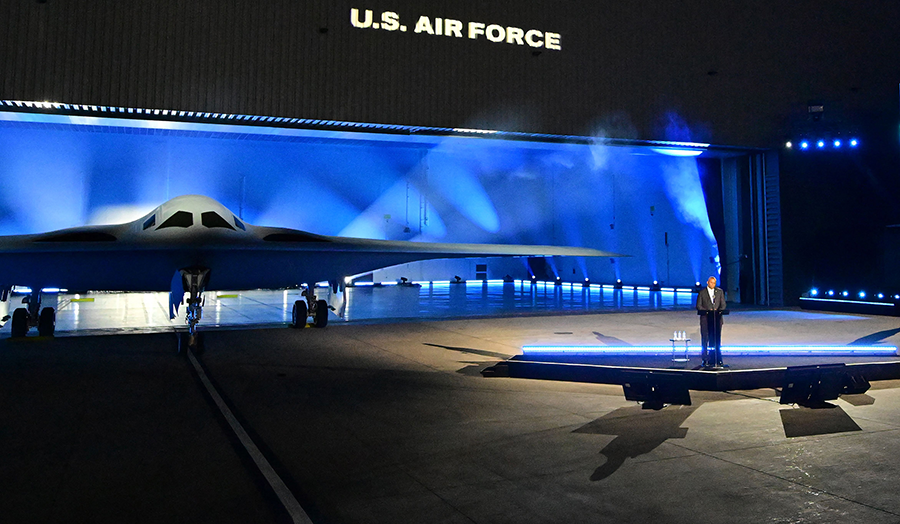"I find hope in the work of long-established groups such as the Arms Control Association...[and] I find hope in younger anti-nuclear activists and the movement around the world to formally ban the bomb."
Congress Boosts Defense Budget Beyond Biden’s Request
January/February 2023
By Shannon Bugos
For the second consecutive year, Congress deemed President Joe Biden’s proposed national defense budget insufficient to counter growing inflation and rising security threats, prompting lawmakers to increase the fiscal year 2023 defense authorization by $45 billion over Biden’s $813 billion request.
 “There were compromises made to get this bill across the finish line,” acknowledged House Armed Services Committee Chairman Adam Smith (D-Wash.) on Dec. 8. But “now more than ever, at a time when global democracy is under attack and the rules-based international order is being threatened, we need a strong national security and defense strategy, and this bill helps us deliver on that front.”
“There were compromises made to get this bill across the finish line,” acknowledged House Armed Services Committee Chairman Adam Smith (D-Wash.) on Dec. 8. But “now more than ever, at a time when global democracy is under attack and the rules-based international order is being threatened, we need a strong national security and defense strategy, and this bill helps us deliver on that front.”
The House passed the 2023 National Defense Authorization Act (NDAA) by a vote of 350–80 on Dec. 8, followed by an 83–11 vote in the Senate on Dec. 15. Biden signed the bipartisan legislation into law on Dec. 23. The NDAA totals $848 billion. An additional $10 billion of national discretionary defense spending falls outside of the armed services committees’ authority. The $858 billion defense topline is an increase of $80 billion, or 10 percent, over the 2022 national defense budget.
The New York Times, citing an analysis by the Center for Strategic and International Studies, reported on Dec. 18 that the new total means the Pentagon budget has grown 4.3 percent annually over the last two years, after inflation, compared to 1 percent in real dollars from 2015 to 2021. Military spending is on track to reach its highest level in inflation-adjusted terms since 2008–2011, during the peaks of the wars in Iraq and Afghanistan, the newspaper said.
The chairpersons and ranking members of the House and Senate armed services committees settled on compromise NDAA text on Dec. 6. Although the House passed its version of the legislation in July, the full Senate did not and brought its armed services committee’s version to the negotiations. (See ACT, September 2022.)
Sen. Jim Inhofe (R-Okla.), ranking member of the armed services committee, described the Biden administration’s defense budget request, released in March, as “woefully inadequate.” (See ACT, June 2022.) The compromise bill corrects course by “prioritiz[ing] nuclear modernization amid Chinese nuclear breakout,” and stays “tough on Russia,” Inhofe stated Dec. 6.
Although the NDAA authorizes funding, appropriations bills allow for actual spending. The fiscal year 2023 defense and energy and water appropriations bills, which, on the whole, reflect the same budget levels in the defense authorization bill, passed through the Senate on Dec. 22 and the House on Dec. 23. Biden signed the omnibus appropriations legislation on Dec. 29.
For the most part, the 2023 NDAA either fully authorizes or boosts the requested budgets for U.S. nuclear weapons modernization programs, including delivery systems and warheads. In addition to mandating some reporting requirements to bolster congressional oversight on nuclear matters, the law adds funding for a new nuclear-armed sea-launched cruise missile (SLCM) and an associated low-yield warhead and allows only a partial retirement of the megaton B83 gravity bomb fleet. It fails to reverse language that undermines support for the international organization that monitors the world for signs of nuclear testing.
Nuclear Delivery Systems
The Biden administration requested no funding for the new nuclear-armed SLCM as it views the capability as unnecessary and potentially detrimental to other priorities.
 Further developing this SLCM “would divert resources and focus from higher modernization priorities for the U.S. nuclear enterprise and infrastructure, which is already stretched to capacity after decades of deferred investments,” the White House noted in an administration policy statement in October.
Further developing this SLCM “would divert resources and focus from higher modernization priorities for the U.S. nuclear enterprise and infrastructure, which is already stretched to capacity after decades of deferred investments,” the White House noted in an administration policy statement in October.
Although Defense Secretary Lloyd Austin and Navy Secretary Carlos Del Toro concur with this assessment, members of Congress from both parties and other defense officials do not.
“No one can tell in an uncertain world what we will need, but it’s important to keep this option available,” said Rep. Jim Cooper (D-Tenn.), who led the House effort to insert funding for the capability, in July.
Gen. Mark Milley and Adm. Christopher Grady, chairman and vice chairman of the Joint Chiefs of Staff, respectively, wrote in June that they see value in the nuclear-armed SLCM due to “its distinct contribution.”
The NDAA authorizes $25 million for the Pentagon to develop the missile and $20 million for the National Nuclear Security Administration (NNSA) to develop the associated warhead, the W80-4 Alt SLCM.The law also requires reports on the concept of operations, operational implications, and costs of the capability, as well as a detailed, unclassified summary of the analysis of alternatives for the missile before the Pentagon can move into the development and demonstration phases.
Congress also authorized $6.2 billion, slightly more than the administration’s request, for construction and continued research and development on a future fleet of 12 Columbia-class ballistic missile submarines.
The Air Force, meanwhile, received an authorization of $4.9 billion for the B-21 Raider dual-capable strategic bomber, a decrease of $110 million from the request. On Dec. 2, the service unveiled the new highly secretive bomber, which will take its first flight in 2023 and is slated to be deployed later this decade. Six bombers are under construction, and the Pentagon plans to acquire at least 100 bombers total.
Lawmakers authorized $3.6 billion, slightly over the request, for replacement of the Minuteman III intercontinental ballistic missile (ICBM) and supporting infrastructure with the new Sentinel system. They banned any decrease in the number of deployed ICBMs, currently 400. Congress also authorized the requested $981 million for the new nuclear-capable, long-range standoff (LRSO) weapons system to replace the
air-launched cruise missile.
Nuclear Warheads
For the NNSA, Congress authorized the Biden administration’s requests of $672 million for the B61-12 gravity bomb, $680 million for the W87-1 ICBM warhead, and $1.1 billion for the W80-4 LRSO weapons system warhead upgrade.
Congress also approved the agency’s $241 million request for the controversial new high-yield submarine-launched ballistic missile warhead, the W93, and authorized the Pentagon to receive $97.1 million to develop the warhead’s aeroshell.
According to the 2022 Nuclear Posture Review, the Biden administration, reversing Trump administration policy, aims to follow through on retiring the megaton-class B83-1 gravity bomb, but Congress has now slowed that process. The NDAA only allows for the deactivation or retirement of up to 25 percent of the B83-1 fleet until the Pentagon submits a report to Congress. (See ACT, December 2022.)
Meanwhile, the NNSA program for producing plutonium pits for nuclear weapons received $500 million more than the administration’s $758 million request for the Savannah River Site location, while the Los Alamos site was authorized for the requested $1.6 billion.
According to an internal NNSA document, pit production is running more than a year behind schedule, largely due to the COVID-19 pandemic. NNSA Administrator Jill Hruby acknowledged last spring that the agency will not reach its goal of producing 80 pits a year by 2030.
Hypersonic Weapons
Congress also broadly threw its full support behind the Pentagon’s hypersonic weapons programs.
The Air Force’s air-launched hypersonic boost-glide vehicle, the Air-Launched Rapid Response Weapon (ARRW), received $47 million less than the request and the authorization for a total of $115 million. The system hit a major milestone Dec. 9 with the successful completion of its first all-up-round test, meaning a test of the full prototype operational missile, off the southern California coast.
“Following the ARRW’s separation from the [B-52H Stratofortress bomber], it reached hypersonic speeds greater than five times the speed of sound, completed its flight path and detonated in the terminal area,” an Air Force statement said. The service aims to conduct three more all-up-round tests before deciding whether to move into production.
Congress added $145 million to the requested $317 million for the Air Force’s Hypersonic Attack Cruise Missile program.
As for the Navy, the service received a $20 million increase for the Conventional Prompt Strike (CPS) program, bringing the total to $1.2 billion, and a $67 million increase for the Hypersonic Air-Launched Offensive Anti-Surface Warfare Weapon, for a total $160 million.
The Navy’s CPS program shares the common hypersonic glide-body vehicle with the Army’s Long-Range Hypersonic Weapon (LRHW), which could enter the field in 2023. Congress authorized $1.1 billion for the Army’s hypersonics program, an increase of $50 million above the request, to account for the National Hypersonic Initiative, which will improve coordination and address any development gaps among the hypersonic weapons programs.
In late October, the Pentagon conducted two test launches of rockets, each carrying about a dozen different experiments, meant to inform continued development of the CPS and LRHW systems.
The NDAA also requires a report on the ARRW, CPS, and LRHW programs to assess their respective costs, schedules, and potential alternatives.
Various hypersonics programs overseen by the Defense Advanced Research Projects Agency received substantial increases in the authorized budget. Glide Breaker jumped from $18 million to $38 million, Tactical Boost Glide from $30 million to $65 million, and Operation Fires, which was in line to be zeroed out, received $42 million. The MoHAWC hypersonic air-launched cruise missile program was authorized for its requested $60 million.
Missile Defense
The NDAA authorized the Pentagon’s efforts for hypersonic missile defense at $518 million, a 1.3 percent increase above the request.
The Space Force landed $830 million for its effort to build a satellite system to track missiles, including hypersonic weapons, which marked a 30 percent increase from the request. This effort includes plans by the Space Development Agency, now part of the Space Force, for the development of a tracking layer.
Congress also authorized the requested $2.8 billion for the Ground-Based Midcourse Defense weapons system based in Alaska and California, which includes $1.8 billion for the Next Generation Interceptors.
Lawmakers boosted the budget requests for the Terminal High Altitude Area Defense missile system by $165 million to $587 million to buy 15 additional interceptors and for the Aegis ballistic missile defense system by $245 million to $2 billion.
Risk Reduction
The NDAA contains a slight $13 million increase above the $354 million request for the Cooperative Threat Reduction program to account for inflation. In each of the previous two fiscal years, Congress significantly boosted the program’s budget by more than $100 million. This program is aimed at reducing threats from weapons of mass destruction and related challenges, including the spread of dangerous pathogens such as COVID-19.
The NDAA omitted language originally in the House version that would have repealed the restriction, imposed by the 2018 NDAA, on funding the Preparatory Commission for the Comprehensive Nuclear-Test-Ban Treaty Organization, which oversees the systems in place to detect signs of nuclear testing across the world.
